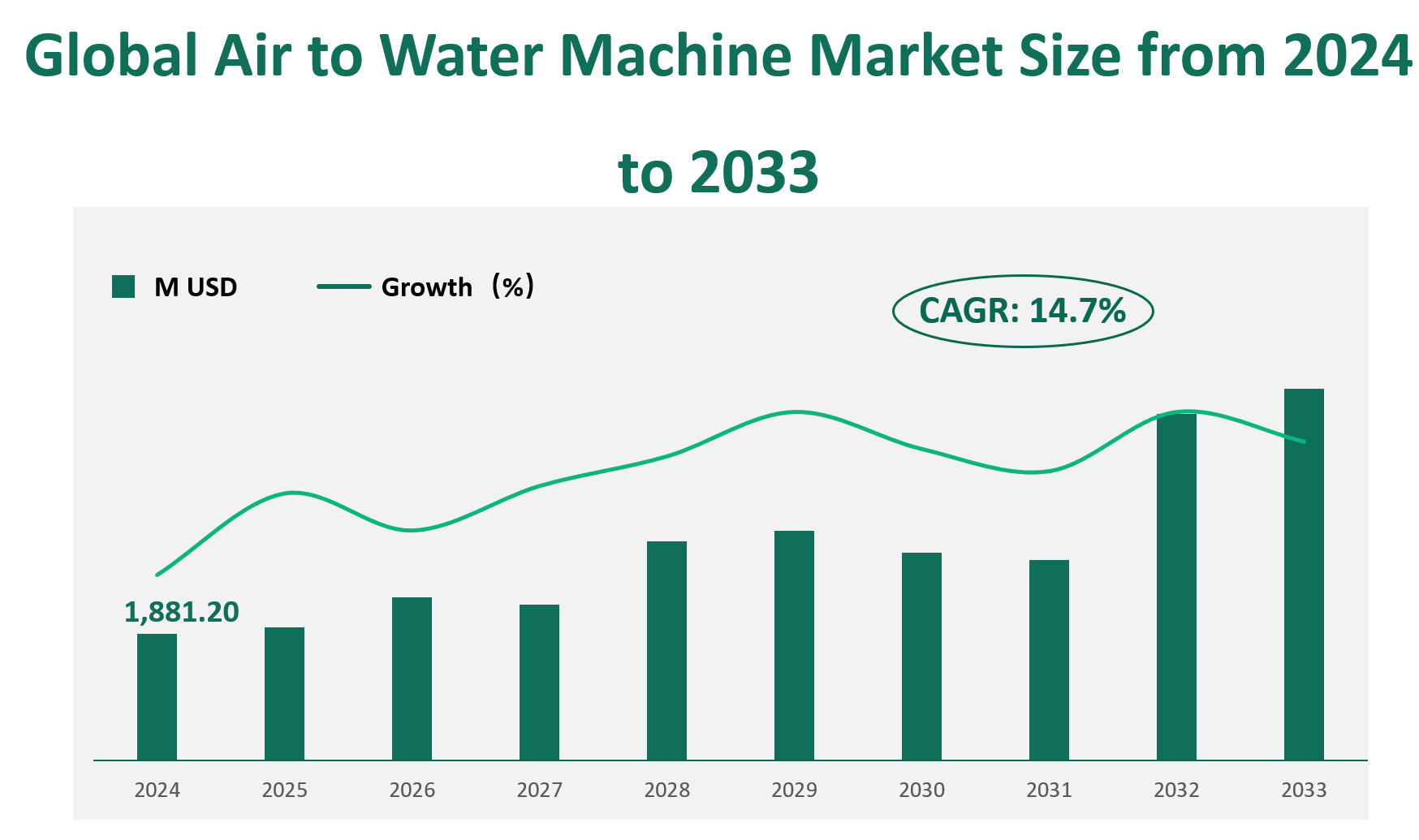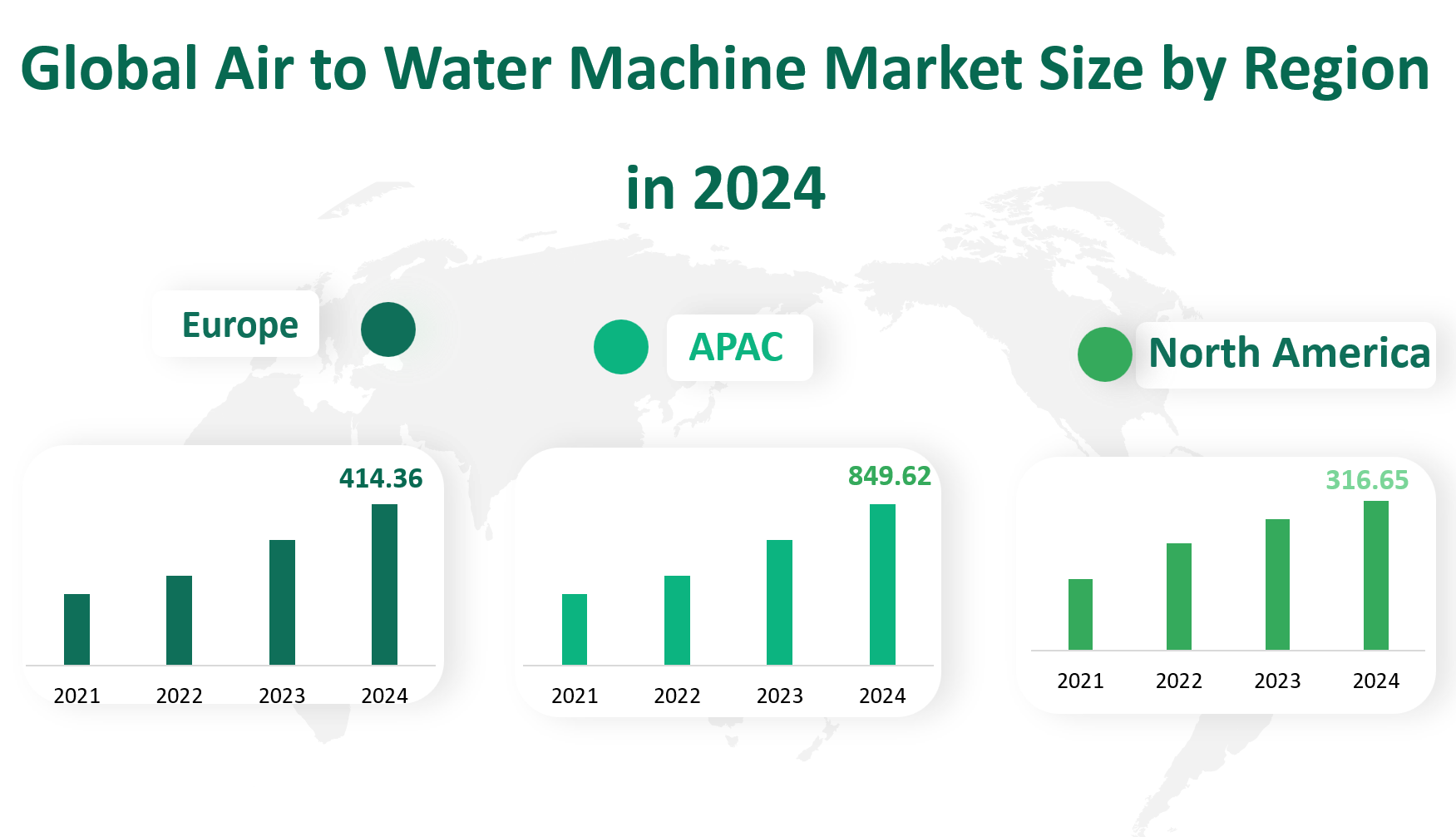1. Global Air to Water Machine Market Insight Analysis
In 2024, the global Air to Water Machine market revenue is projected to reach $1,881.20 million, with a Compound Annual Growth Rate (CAGR) of 14.70% from 2024 to 2033.
An Air to Water Machine is a revolutionary device that extracts drinking water from the air by condensing atmospheric humidity. This technology leverages the moisture present in the air, converting it into potable water through a series of filtration and purification processes. Unlike traditional water sources, these machines do not rely on external water supplies, making them ideal for regions with limited water infrastructure or frequent water shortages. The machines are designed to operate efficiently in various climates, producing water with minimal environmental impact. They are particularly beneficial in areas with high humidity, where they can generate significant amounts of water daily.
Figure Global Air to Water Machine Market Size (M USD) and CAGR (2024-2033)

2. Driving and Limiting Factors of Air to Water Machine Market Growth
The growth of the Air to Water Machine market is driven by several key factors. The most significant is the increasing global water scarcity, exacerbated by population growth, urbanization, and climate change. As traditional water sources become more strained, the demand for alternative water solutions like Air to Water Machines rises. These machines offer a sustainable and efficient way to produce water, reducing reliance on bottled water and decreasing the environmental impact of water transportation and storage.
Another driving factor is the growing awareness of water quality issues. With increasing pollution and contamination of traditional water sources, consumers are seeking cleaner and safer drinking water. Air to Water Machines provide a solution by extracting pure water from the air, bypassing the need for potentially contaminated water supplies. Additionally, advancements in technology have made these machines more efficient and cost-effective, further enhancing their appeal.
However, the market also faces several limiting factors. One major challenge is the high initial cost and maintenance expenses associated with Air to Water Machines. These costs can be prohibitive for many consumers and businesses, especially in developing regions. Additionally, the efficiency of these machines is influenced by environmental conditions, such as humidity and temperature. In areas with low humidity or extreme temperatures, the machines may not produce sufficient water, limiting their effectiveness.
Another limiting factor is the competition from established water supply systems and traditional water purification methods. Many regions already have well-developed water infrastructure, making it difficult for Air to Water Machines to penetrate the market. Additionally, regulatory and policy barriers can hinder the adoption of new technologies, as governments may prioritize existing water management solutions.
3. Technology Innovation and Corporate Mergers and Acquisitions in Air to Water Machine Market
Technological innovation is a key driver in the Air to Water Machine market. Companies are continuously investing in research and development to improve the efficiency and capacity of their machines. Recent advancements include the integration of smart technologies, such as IoT (Internet of Things) sensors, which allow for remote monitoring and control of the machines. These innovations not only enhance the user experience but also improve the overall performance and reliability of the devices.
Corporate mergers and acquisitions are also shaping the market landscape. Major players are acquiring smaller companies to expand their product portfolios and gain access to new technologies. For example, Watergen, a leading Israeli company in the Atmospheric Drinking Water Equipment (AWG) market, partnered with Mullen Automotive to develop water-from-air solutions for electric vehicles. This partnership aims to provide fresh drinking water to vehicle occupants by integrating AWG technology into Mullen’s fleet of electric vehicles.
Other notable developments include the expansion of distribution networks and the establishment of strategic partnerships. Companies are focusing on expanding their reach into emerging markets, particularly in regions with high water scarcity. For instance, Airowater, an atmospheric water generator company, raised $20 million to fund its expansion plans, targeting markets in India and Africa.
4. Global Air to Water Machine Market Size by Type
Air to Water Machines are categorized based on their water production capacity, with three primary types: Below 100L, 100-5000L, and Above 5000L.
The Below 100L category includes small-scale Air to Water Machines designed for residential and small commercial use. These machines are compact and suitable for households, offices, and small businesses. They typically produce up to 100 liters of water per day and are ideal for environments with limited space and moderate water requirements. The market size is estimated to reach US$ 238.38 million.
The 100-5000L category encompasses mid-range Air to Water Machines, designed for larger commercial and industrial applications. These machines can produce between 100 and 5000 liters of water per day, making them suitable for hotels, restaurants, schools, and small industrial units. They offer a balance between capacity and energy efficiency, making them a popular choice for businesses with moderate to high water needs. The 100-5000L segment have a substantial market size in 2024, estimated at US$ 866.28 million.
The Above 5000L category includes large-scale Air to Water Machines designed for industrial and heavy commercial use. These machines are capable of producing over 5000 liters of water per day and are typically used in large industrial plants, agricultural fields, and remote locations where water infrastructure is limited. They are engineered to provide a continuous and large supply of water, making them essential for operations that require significant water volumes. The Above 5000L segment have a market size of US$ 776.55 million in 2024.
Table Global Air to Water Machine Market Size by Type in 2024
5. Global Air to Water Machine Market Size by Application
Air to Water Machines are utilized across various applications, including residential, commercial, and industrial settings.
The residential application of Air to Water Machines involves providing clean drinking water to households. These machines are designed to meet the daily water needs of families, ensuring a reliable and sustainable water supply. They are particularly useful in areas with limited access to clean water or where water infrastructure is unreliable. The residential application is projected to generate a market revenue of US$ 235.77 million in 2024.
The commercial application of Air to Water Machines includes their use in hotels, restaurants, offices, and other commercial establishments. These machines provide a reliable water supply for daily operations, ensuring that businesses can meet their water needs without relying on external sources. They are particularly valuable in areas with water scarcity or where water quality is a concern. The commercial application is expected to have a market revenue of US$ 587.62 million in 2024.
The industrial application of Air to Water Machines involves their use in large-scale industrial operations, including manufacturing, agriculture, and mining. These machines provide a continuous and large supply of water, essential for industrial processes and operations. They are particularly valuable in remote locations where water infrastructure is limited. The industrial application is projected to generate a market revenue of US$ 1,090.21 million in 2024.
Table Global Air to Water Machine Market Size by Application in 2024
|
Application |
Market Size (M USD) 2024 |
|
Residential |
203.37 |
|
Commercial |
587.62 |
|
Industrial |
1090.21 |
6. Global Air to Water Machine Market by Top Regions
The North American market is projected to generate a revenue of US$ 316.65 million in 2024. This region includes the United States and Canada, both of which have seen significant adoption of Air to Water Machines due to their advanced technological infrastructure and growing awareness of water conservation. The market is driven by residential and commercial applications, with a focus on providing clean drinking water in areas with limited water resources.
Europe is expected to have a market revenue of US$ 414.36 million in 2024. The region’s market is driven by stringent environmental regulations and a growing emphasis on sustainable technologies.
The Asia-Pacific region is projected to have a market revenue of US$ 849.62 million in 2024. This region includes China, Japan, South Korea, India, and Australia, all of which are experiencing rapid urbanization and industrial growth.
Latin America is expected to generate a market revenue of US$ 100.80 million in 2024. The region includes countries like Mexico, Brazil, and Argentina, which face significant water scarcity issues.
The Middle East and Africa region is projected to have a market revenue of US$ 199.78 million in 2024.
Figure Global Air to Water Machine Market Size by Region in 2024

7. Global Air to Water Machine Market Analysis by Major Players
7.1 Shenzhen FND
Company Introduction and Business Overview:
Shenzhen FND is a leading manufacturer of Air to Water Machines, headquartered in China. Established in 2013, the company specializes in water purification and sustainable water solutions. Shenzhen FND offers a wide range of products, including residential and commercial Air to Water Machines, designed to provide clean drinking water in areas with limited water resources.
Products Offered:
Shenzhen FND’s product portfolio includes small-scale machines for residential use and large-scale machines for commercial and industrial applications. Their products are known for their efficiency, reliability, and sustainability.
Sales Revenue in 2022:
In 2022, Shenzhen FND achieved a sales revenue of US$ 168.05 million.
7.2 Hendrx
Company Introduction and Business Overview:
Hendrx, headquartered in China, is a prominent player in the Air to Water Machine market. Established in 1993, the company focuses on providing innovative water solutions, including atmospheric water generators and filtration systems. Hendrx’s products are designed to meet the needs of residential, commercial, and industrial customers.
Products Offered:
Hendrx offers a range of Air to Water Machines, from small-scale residential units to large-scale industrial systems. Their products are known for their advanced technology and reliability.
Sales Revenue in 2022:
In 2022, Hendrx achieved a sales revenue of US$ 94.17 million.
7.3 WaterMicroworld International
Company Introduction and Business Overview:
WaterMicroworld International, headquartered in Spain, is a leading provider of atmospheric water generators. Established in 2008, the company specializes in developing and distributing innovative water solutions for residential, commercial, and industrial applications. Their products are designed to provide clean drinking water in areas with limited water resources.
Products Offered:
WaterMicroworld International offers a range of Air to Water Machines, including small-scale residential units and large-scale industrial systems. Their products are known for their efficiency and sustainability.
Sales Revenue in 2022:
In 2022, WaterMicroworld International achieved a sales revenue of US$ 57.11 million.

